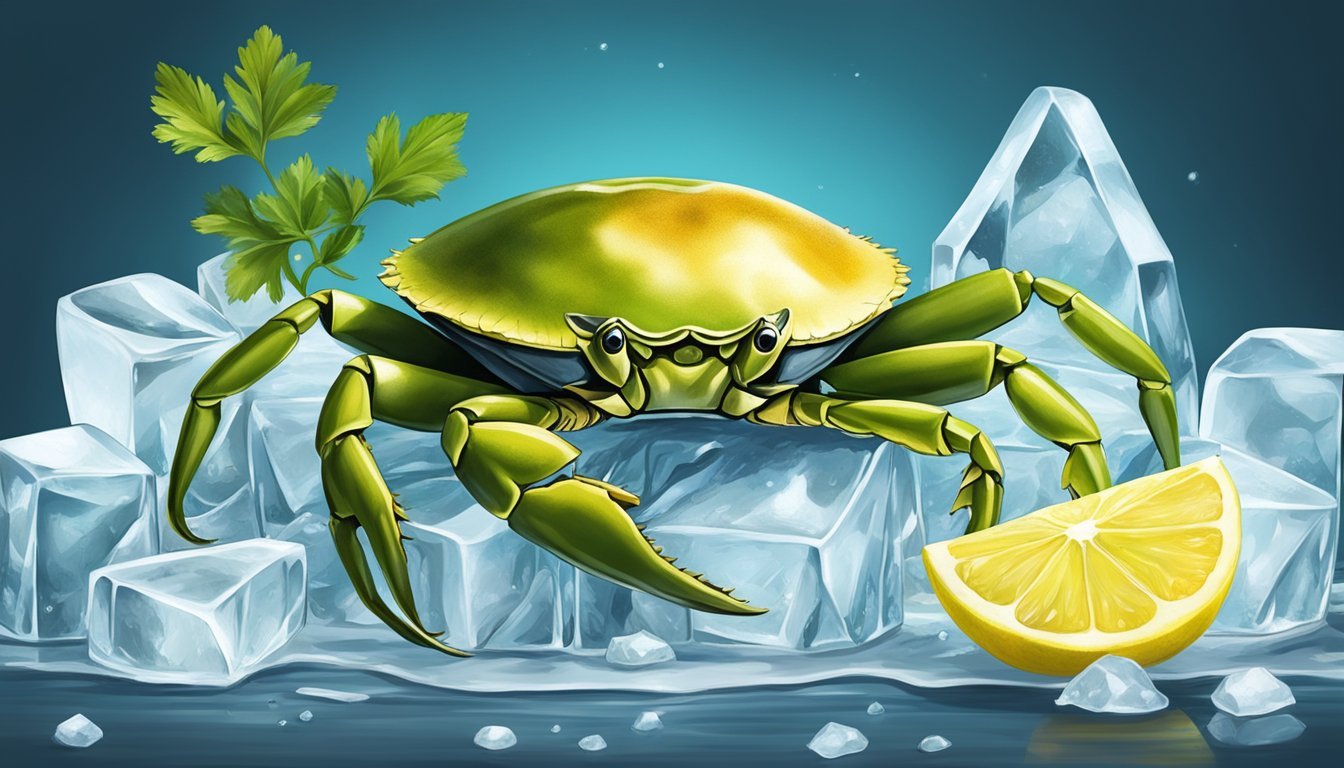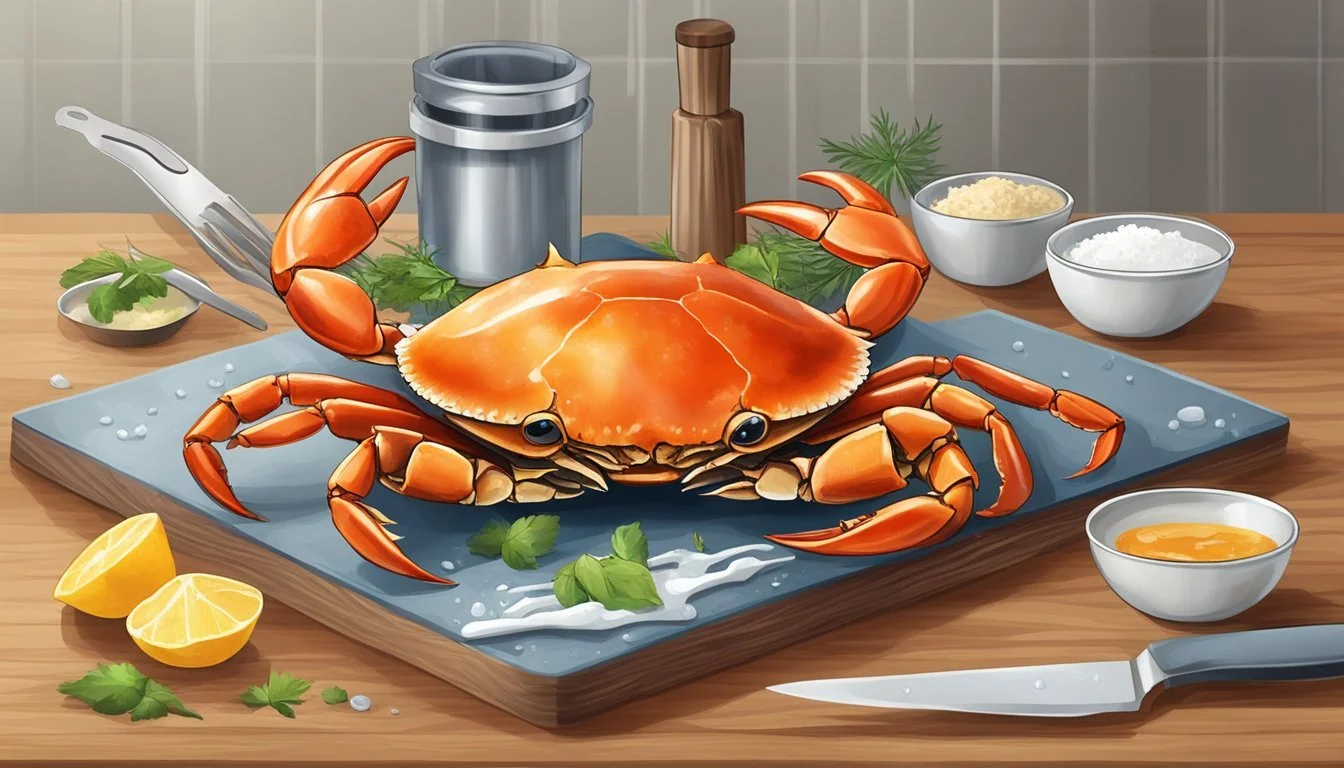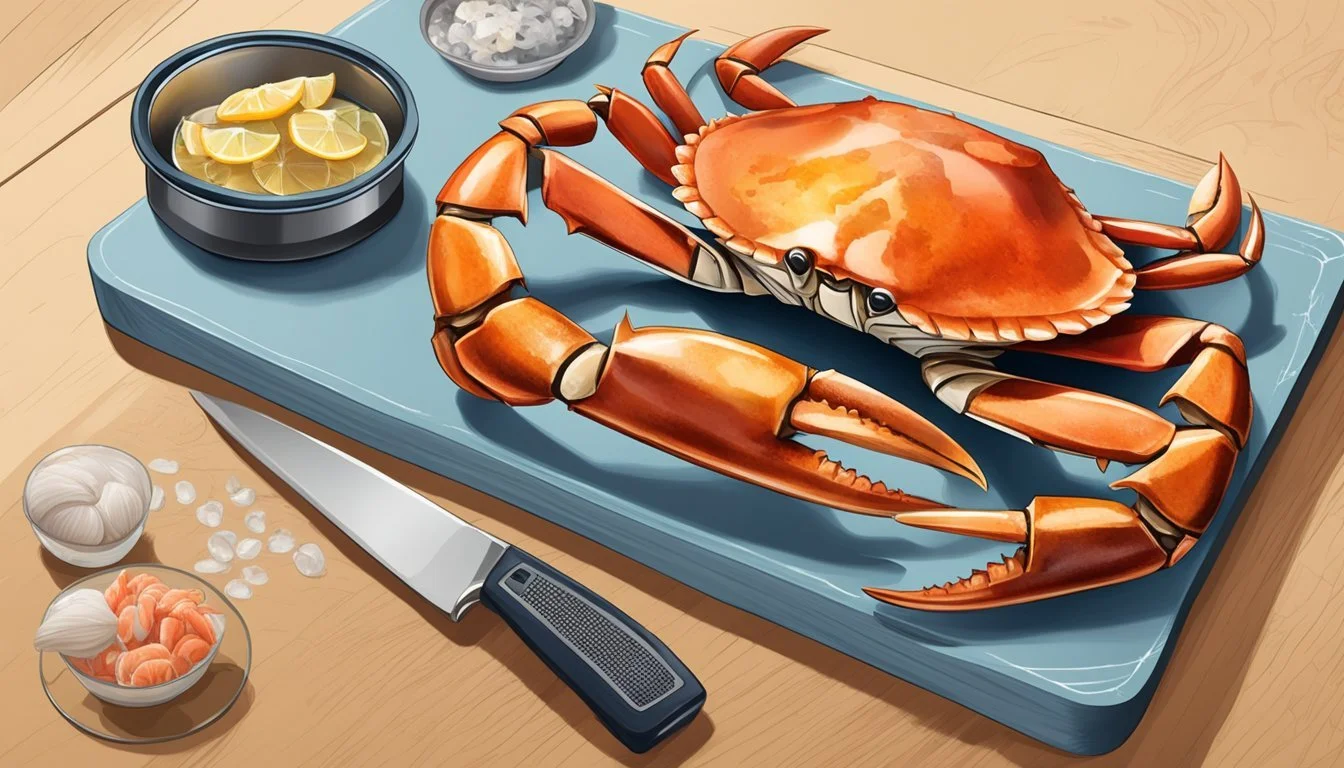How Long Does Crab Last?
Shelf Life and Storage Tips
Crab (What wine goes well with crab?) is a delectable seafood (What wine goes well with seafood?) enjoyed by many, but its freshness and quality are paramount to its flavor and safety. Generally, cooked crab(What wine goes well with crab?) can last between 3 to 5 days in the refrigerator when stored at a temperature of 35 to 40 degrees Fahrenheit. It is essential to refrigerate crab within two hours of cooking to prevent bacterial growth that can compromise its safety and taste. The texture of crab meat is also an indicator of its freshness; ideally, the meat should retain a firm yet tender consistency.
The proper storage of crab is key to maintaining its quality. Uncooked crab meat should be used within three to four days of purchase, ensuring it's kept refrigerated at all times. Once cooked, the shelf life extends for an additional 3 to 4 days. The smell of crab can also indicate its condition; fresh crab should have a sea-like aroma, while any sour or ammoniated smell suggests it's no longer safe to eat.
For those looking to keep crab longer, freezing is a viable option, extending its edibility to 2 to 3 months. However, freezing can alter the texture, possibly resulting in the moisture separating from the meat upon thawing. This can lead to a less desirable consistency, though the crab meat remains safe for consumption if proper freezing techniques are employed and the crab is used soon after thawing.
Understanding Crab Quality and Freshness
Evaluating the quality and freshness of crab involves inspecting its physical attributes that signal its current condition. These indicators are crucial as they directly relate to the crab's safety for consumption and overall taste.
Visual Cues
One can gauge the freshness of crab by its appearance. Fresh crab meat should have a bright red hue when cooked and a faintly translucent or ivory color when uncooked. Discoloration, such as dark spots or yellowing, can suggest deterioration. In live crabs, look for lively movement and a bright shell color; lethargy or a dull shell may indicate poor quality.
Odor Evaluation
Crab should emit a briny, sea-like smell indicative of its ocean origin. Any off smell or sour smell is a red flag signaling that the crab is no longer fresh and may have spoiled. A strong, ammonia-like odor is a clear sign that the crab should not be consumed.
Texture Assessment
The texture of crab meat is another key aspect of its freshness. Fresh, cooked crab meat should be firm and springy to the touch. Conversely, if the crab meat feels slimy or has a mushy consistency, it has likely gone bad and should not be used. Fresh crab meat, both cooked and uncooked, will have a consistent, pleasant texture free from any sliminess.
Proper Storage Methods
Ensuring the longevity and safety of crab meat hinges on proper storage methods. By adhering to specific temperatures and using the right containers, one can significantly extend crab meat's shelf life.
Refrigerating Cooked Crab
Cooked crab should be refrigerated at a steady temperature to maintain freshness and prevent spoilage. The ideal temperature for refrigeration is between 32°F and 40°F. It is imperative to store cooked crab in an airtight container or wrap it tightly with plastic wrap or aluminum foil to minimize exposure to air and moisture. Under these conditions, cooked crab can last in the refrigerator for 3 to 5 days.
Freezing Crab for Long-Term Storage
For long-term preservation, freezing is the most effective method. Crab should be stored in the freezer at 0°F or below. To prepare crab for freezing, one should use freezer-safe bags or airtight containers to prevent freezer burn. Additionally, wrapping the crab in freezer wrap or vacuum sealing it can further protect its quality. When stored correctly, frozen crab can be kept for several months, but for optimal taste and quality, it is best consumed within 3 to 4 months. Always thaw frozen crab in the refrigerator overnight before use.
Shelf Life of Crab Varieties
The shelf life of crab and its variants depends largely on the state in which it's stored—whether it's fresh, cooked, or frozen. Proper storage is critical to extend the crab's viability and ensure safety for consumption.
Fresh and Live Crab
Fresh and live crab are best when consumed within a very short time after purchase. Live crabs should be kept alive until cooked and stored in a ventilated container at a temperature close to 32 degrees Fahrenheit. They should be cooked within 48 hours of purchase. Fresh crab meat, if not cooked, should be refrigerated and used within two days.
Cooked Crab Meat
Once crab is cooked, cooked crab meat has a limited window of freshness. In a refrigerator kept at 35-40 degrees Fahrenheit, cooked crab can last between three to seven days. It's vital to store the crab in a sealed container or wrap it securely to maintain its quality. Leftovers from crab dishes such as crab cakes (What wine goes well with crab cakes?) should also be refrigerated and consumed within this timeframe.
Frozen Crab and Its Variants
Freezing crab can significantly extend its shelf life. Raw crab meat can be stored in an airtight container or a zip lock bag and frozen, with lump crab meat retaining quality for up to six months. Cooked crab can be frozen for up to three months. Differing varieties such as king crab, Dungeness crab, snow crab, and stone crab can also be frozen, with the freeze time potentially varying based on the fattiness and texture of the meat. It's crucial to store crab in the coldest part of the freezer and ensure it's wrapped tightly to prevent freezer burn. When ready to consume, thawing in the refrigerator is recommended for maintaining the best texture and flavor.
Safety Tips for Consuming Crab
When enjoying crab, consumers must be vigilant to ensure the quality and safety of the seafood to prevent foodborne illness. Identifying spoilage signs and taking preventive measures are critical steps.
Recognizing Spoilage Signs
One should inspect crab meat for any offensive odors, discoloration, or slimy texture—all of which are indicators of spoilage. If the crab was previously frozen and thawed, one must be particularly attentive as signs of spoilage may be less apparent. The presence of mold on the crab's shell or flesh is a definite sign that the crab is not safe for consumption.
Odors: A strong, sour, or ammonia-like smell is a clear indication the crab is no longer safe to eat.
Visual Inspection: Crabs that display any discoloration or signs of mold should be discarded.
Texture: Slimy or mushy consistency in crab meat is a sign of bacterial growth and spoilage.
Preventing Foodborne Illness
Proper handling and storage are paramount to mitigate health risks associated with bad crab. Always store crab in the coldest part of the refrigerator at or below 40°F (4°C). For longer storage, freezing at 0°F (-18°C) is recommended.
Refrigeration: Cooked crab meat should be eaten within 2-5 days when stored in the fridge.
Freezing: Freezing crab can extend its shelf life to 6-9 months.
Cross-Contamination: Prevent cross-contamination by keeping cooked crab away from raw foods and using clean utensils and surfaces.
Cooking Guidelines: Ensure that crabs are cooked to an internal temperature of 145°F (63°C).
By adhering to these safety practices, consumers can enjoy crab delicacies while minimizing potential health risks associated with foodborne bacteria.
Thawing and Preparation Techniques
Proper thawing and preparation techniques are crucial for preserving the texture and flavor of crab meat. By following the correct methods, one ensures the crab reaches the ideal internal temperature for optimal taste and safety during cooking.
Correct Thawing Methods
To maintain the quality of crab meat, thawing should be done slowly in the refrigerator. This method can take up to 48 hours, depending on the size of the crab or crab legs. A faster alternative involves placing the crab in a sealed plastic bag and submerging it in cold water, changing the water every 30 minutes to ensure it continues to thaw safely.
Refrigeration:
Place crab in the fridge for 24-48 hours.
Ideal for large crab legs or whole crabs.
Cold Water Method:
Seal in plastic bag, fully submerge in cold water.
Change water every 30 minutes.
Thaw time is typically faster than refrigeration.
Preparing for Cooking and Consumption
Once fully thawed, the crab is ready for preparation and cooking. To enhance flavor and texture, one may steam crab legs for 4-5 minutes if they are already cooked, or longer if they are raw. Crab meat is also commonly used in a variety of dishes such as casseroles or crab cakes.
Steaming:
Pre-steam: Ensure crab is fully thawed.
Steam time for cooked thawed crab: 4-5 minutes.
Use a steamer or a pot with a steamer insert.
Preparation for Recipes:
Crab cakes: Blend crab meat with binding ingredients, shape, then cook.
Casseroles: Mix crab meat with other components before baking.
Microwaving crab is generally not recommended as it can unevenly heat the meat and affect its texture.
Guidelines for Cooking Seafood
In order to ensure seafood is cooked to perfection, maintaining proper cooking temperatures and times is essential not only for safety but also to preserve the quality, flavor, and texture of the protein.
Cooking Temperature and Times
Shellfish (e.g., crabs, lobster (What wine goes well with lobster?), shrimp):
Cook until the flesh is pearly or white, and opaque.
Finfish:
Should reach an internal temperature of 145°F for safety. Use a food thermometer to verify.
Cooking Time Chart:
Type of Seafood Cooking Time (approx.) Lobster 8-12 minutes Shrimp 3-4 minutes Clams 5-7 minutes
Best Practices for Seafood Preparation
Before cooking, seafood should be clean and prepared in a sanitary environment to avoid contamination.
Marinades can enhance the flavor and quality of seafood; however, marinade times should be brief to prevent breaking down the delicate protein.
Always defrost seafood in the refrigerator or under cold water if it is frozen to maintain texture integrity.
Utilize a thermometer to ensure seafood has reached its safe internal temperature before serving, especially important in proteins like seafood where undercooking can present significant health risks.
Maximizing Freshness and Quality
To ensure that crab meat maintains its freshness and quality, attention to packaging and proper storage conditions is essential. These factors are critical in preserving the taste, texture, and safety of the crab meat, whether it is fresh or cooked.
Packaging and Protection
Proper packaging is crucial to protect crab meat from exposure to air, which can accelerate spoilage through oxidation. Fresh crab meat should be sealed in airtight containers or vacuum-sealed bags to minimize exposure to air and reduce the risk of bacterial growth. For cooked crab meat, once it has cooled, it should be wrapped tightly in cling film or placed in an airtight container before storing.
Maintaining Optimal Storage Conditions
The right storage conditions can significantly extend the shelf life of crab meat. Refrigeration should be at a constant temperature of 40°F (4°C) or below to minimize the risk of bacterial proliferation. Freezing crab meat is another option for long-term storage, with the potential to maintain quality for 2 to 3 months. To avoid freezer burn, ensure that crab meat is wrapped properly, removing as much air as possible from the packaging.
Refrigeration: Cooked crab should last 3-5 days.
Freezing: Properly packaged crab can last 2-3 months.
Determining Best Quality Before Purchase
When purchasing crab meat, one should assess its freshness to ensure they are starting with the best quality. Fresh crab meat should have a mild scent of the sea without any overwhelming fishy odors. The flesh should appear vibrant and moist without any discoloration or dryness. For live crabs, the livelier they are, the fresher they tend to be, and they should be cooked within 12 hours of purchase.
Post-Purchase Care and Handling
Effective post-purchase care is essential for maintaining the quality and safety of crab meat. It's important to manage temperature control meticulously during transport and storage.
Transport and Immediate Storage
Upon purchasing crabs, it is imperative that they are kept cold to prevent spoilage. Transporting the seafood should be done with the crabs either in an insulated cooler filled with ice or in a cold storage compartment of a vehicle. Once home, immediate storage must ensure that the crabs are kept at a consistent, cold temperature. Place the crabs in the coldest part of the refrigerator, usually on the back or bottom shelf.
Avoid overcrowding the space to ensure consistent cooling.
Use a thermometer to verify the refrigerator's temperature, aiming for 40°F (4°C) or lower.
Long-Term Freezer Management
For long-term storage, crabs should be preserved in a freezer. To effectively store crab meat in the freezer:
Keep the freezer's temperature at 0°F (-18°C) or below.
Protect against freezer burn by using a vacuum seal or placing crabs in an airtight container or sealed plastic bags.
Labeling the storage container with the date of the freeze helps in following proper storage time guidelines.
Properly frozen and sealed crab can maintain quality for up to 6 to 9 months. Thawing should be done in the refrigerator, allowing for a gradual defrost overnight before use.







